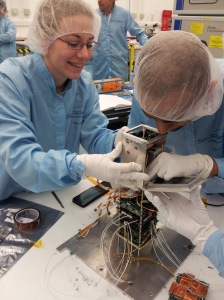The UK smartphone satellite STRaND-1 is expected to launch from India on Monday, Feb. 25 at 12:25 GMT. You can follow the launch on Twitter or watch live video.
STRaND-1 and other CubeSats carrying amateur radio payloads are planned to launch on the ISRO PSLV-C20 rocket into a 785 km orbit.
STRaND-1 carries an amateur radio 9600 bps AX.25 packet radio downlink on 437.568 MHz. It is hoping to be the first ever satellite to carry a smartphone into space and is also believed be the first satellite to use a part produced with a 3D Printer.
On Twitter the Surrey Space Centre @SpaceAtSurrey tweeted:
Official launch hashtag of STRaND-1 spacecraft is #S1Launch. Post launch we will be using #STRaND1 hashtag. Launch time:12.25 GMT 25th Feb 2013 #UniOfSurrey #SSTL
Launch Authorisation Board (LAB) for PSLV – C20 @STRaND mission has cleared the launch on Monday, Feb 25, 2013. @university of surrey #S1Launch
Live video launch feeds for Monday’s PSLV launch http://www.webcast.gov.in/live/ and http://ibnlive.in.com/livetv/
Launch times can and do change at the last minute so follow Twitter for the latest information.
Follow Surrey Nanosats https://twitter.com/SurreyNanosats
Read more about STRaND-1 at http://www.amsat-uk.org/?page_id=12196
STRaND-1 telemetry format http://www.amsat-uk.org/?page_id=12875
STRaND-1 videos http://www.amsat-uk.org/?page_id=12472
Other satellites on the same launch http://www.amsat-uk.org/?p=12180
STRaND-1 on Facebook https://www.facebook.com/nanosats








You must be logged in to post a comment.